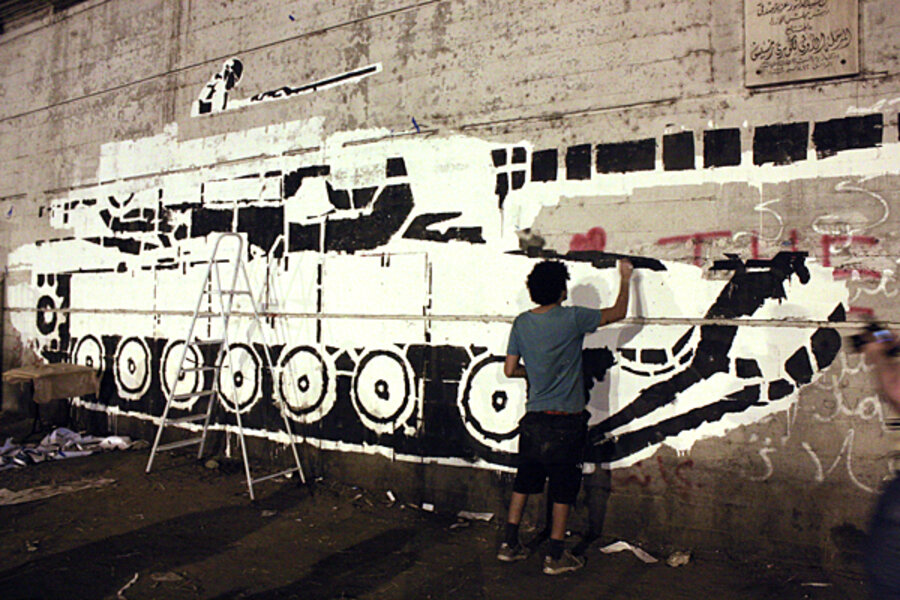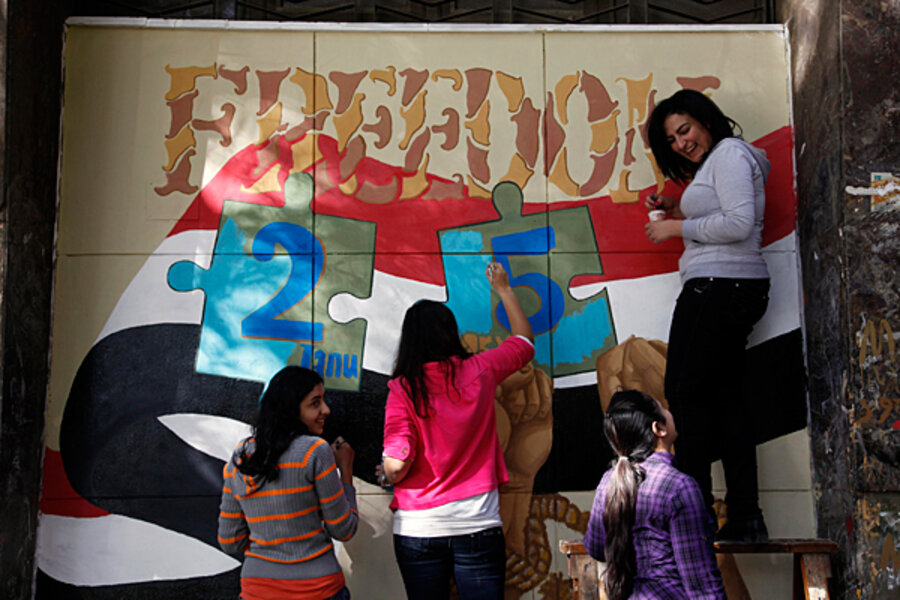Egyptian graffiti artist Ganzeer arrested amid surge in political expression
Loading...
| Cairo
Updated at 2:35 p.m. with news of Ganzeer's release.
Egyptian security forces briefly detained three artists hanging posters in Cairo today ahead of major protests tomorrow – a "second revolution" in the words of activists, who are impatient with the pace of reform under Egypt's interim military rule.
“New…The freedom mask," read the poster, depicting a masked head and gagged mouth. "Greetings from the Supreme Council of the Armed Forces to the beloved people. Now available in the market for an unlimited time.”
The poster was designed by Mohamed Fahmy, an artist known as Ganzeer who was arrested today along with film director Aida El-Kashef, and musician Adel Rahman Amin (a.k.a. NadimX). His work is part of a wave of political and revolutionary graffiti that has sprouted on Cairo’s streets as Egyptians let loose the political expression that was suppressed for years.
“People forget that the streets belong to the people,” said Ganzeer in a Monitor interview at his studio before his arrest. “They think that they're some kind of official government-controlled entity. I think it's important to remind people that they’re not.”
One of Ganzeer's latest images: Tank vs. bicyclist
With his tank art, murals of Egyptians killed in the revolution, and other political graffiti, he’s been doing just that, along with dozens of other artists.
On a recent night, friends and volunteers joined Ganzeer under a bridge in the Egyptian capital after 10 p.m. to help paint one of his images. Working in the yellow light of a street lamp, they taped to the wall huge sheets of paper with large shapes cut out of them. As they rolled the first layer of white paint over the stencils, passersby stopped to stare. Off came the first set of stencils. Up went another set. They slopped on black paint.
As curfew drew near, the image on the wall had become clear: a man riding a bicycle, carrying on his head a tray of bread, known in Egypt by the word that also means “life.” Confronting the bicyclist was an almost life-size tank, a soldier’s profile at the top aiming the gun turret at him.
In a nation where the military has been in control since the fall of former President Hosni Mubarak in February, the message was as black and white as the palette.
Surge in political street art since uprising
Political street art was never prevalent in the Egyptian capital before the uprising. There were scrawled names, of course, and hard-core soccer fans tagged walls and painted designs. But nothing like the tank.
That all changed with the uprising. Suddenly, graffiti was everywhere. “Down with Mubarak” was a popular message. Graffiti, says an artist who goes by the name El Teneen, was “part of the protest.” His own work during those days included a depiction of Mubarak with the word “Leave” underneath.
“At the beginning, people wanted to make a mark. They didn't know how the protests were going to go, so they wanted to make sure there was something permanent left even if the protests didn't succeed,” he says.
Later, he painted a red and white chess board on a downtown wall. On one side were rows of pawns. On the other, the king, toppled.
New artists, new themes – not least of all 'Tantawi's undies'
Like many of the artists who are now using the streets as a canvas, El Teneen was not an experienced graffiti artist before the revolution. Many of Cairo’s artistically inclined seem to have simply picked up a spray can or a paintbrush and decided it was time to do something.
Adham Bakry’s first experience in street art was during parliamentary elections last fall, which ranked among the most fraudulent in Egypt’s history. “It's something I didn't do before. That wouldn't have crossed my mind before. I would have been scared,” he says. Under Mubarak’s regime, the police, known for torture and abuse, as well as corruption, were feared.
While much of the political graffiti in the beginning was aimed at Mubarak, and then his cronies, these days, you can walk the streets of downtown Cairo and find “Down with Tantawi,” a reference to Egypt’s military ruler, scrawled on a wall.
There’s El Teneen’s new depiction of Mohamed Hussein Tantawi and even a depiction of a pair of men’s Army-green briefs, dotted with blue military helicopters. The artist, who asked to remain anonymous, calls it “Tantawi’s undies.”
The proliferation of anti-military graffiti is a reflection of Egyptian activists’ frustration with the military rulers, who they say replaced one autocracy with another.
But those feelings don’t appear to resonate with many Egyptians, who are eager to preserve stability and get Egypt’s economy – and their lives – back on track. Much of the graffiti that has appeared since the revolution is nonpolitical – simply colorful expressions of national pride in the popular uprising.
No one stops to ask, 'Do you have a permit for that?'
Others are honoring the more than 840 Egyptians killed during the revolution, known as martyrs here, by painting their likenesses across the city. Mohamed Hassan and friend Abdullah Ragab designed simple but powerful black-and-white portraits of four of those who died in the uprising, and painted them in different neighborhoods. “We wanted everyone to see them and know that they died for their country,” says Mr. Hassan, an architect by training who works in graphic design.
Ganzeer has designed and painted three huge murals of men who died in the uprising. He hopes to do all 800-plus. When one of them was painted over, presumably by city or military officials, he painted it back, this time depicting the youth flashing a peace sign. Though the martyr murals are more like a memorial, most of his work is political. “It's not decorative. It communicates. It delivers a message,” he says.
As he and friends and volunteers painted the tank, they wondered what would happen if an Army officer showed up. None did, but even so, such encounters have changed. Ganzeer, who had done some street art in Alexandria prior to the revolution, said in the past people would come up and ask “Do you have a permit for that?”
“Now people are either joining in or they mind their own businesses,” he says. “ I'm not sure this will persist but there has been a cultural shift in how people deal with the streets after the revolution.”
El Teneen says it’s still premature to speak of owning the streets, however. “Most of the graffiti is not political,” he says. “Maybe we can say that people are expressing themselves, but the streets aren't ours yet.”
Within hours of Ganzeer's arrest, a #freeganzer page on Twitter and a "Free Mohamed Fahmy" Facebook page had been created to mobilize protests for his release.






